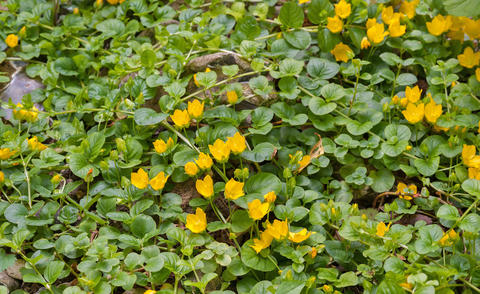Moneywort
The fast-growing pennywort is often found as a ground cover on the edge of the pond. Lysimachia nummularia can also be kept in pots on the balcony and terrace - or as a houseplant. Here are some care tips.
Factsheet
- Growth type
-
- Perennial plant
- Growth height (from)
- from 5 cm to 10 cm
- Growth width (from)
- from 30 cm to 40 cm
- Growth characteristics
-
- flat growing
- carpet forming
- foothills
- Flower color
-
- yellow
- Flowering time (month)
-
- May to July
- Flower shape
-
- simply
- Shell Flowers
- Flower characteristics
-
- unfilled
- Leaf color
-
- green
- page format
-
- full margined
- roundish
- Sheet properties
-
- wintergreen
- Fruit shape
-
- Capsule
- Fruit characteristics
-
- unimpressive
- Light
-
- scattered light to shady
- Soil type
-
- sandy to loamy
- Soil Moisture
-
- fresh to humid
- ph value
-
- neutral
- Lime compatibility
-
- lime-tolerant
- Nutrient requirements
-
- nutrient-rich
- Humus
-
- rich in humus
- Decorative or utility value
-
- Flower Decoration
- native wild plant
- Toxicity
-
- non-toxic
- Winter Hardness
-
- hardy
- Climate zones according to USDA
-
- 4
- areas of life
-
- GR2
- GR3
- FR2
- FR3
- WR4
- Use
-
- ground cover
- Embankments
- Group planting
- Planters
- Pond planting
- Underplanting
- Surface greening
- Garden style
-
- natural garden
- Pot garden
- Forest Garden
- Water garden
The Moneywort (Lysimachia nummularia) is an extremely fast-growing herbaceous perennial, which is particularly interesting in case of aquatic gardens. The plant, also known as mint herb, belongs to the large and diverse family of the primrose family (Primulaceae) and to the genus Loosestrifes (Lysimachia). Just the way, in the garden, they grow near water; in the countryside too, they are found near water, mainly on wet grassland or on damp lakeshores. The Moneywort is native to both Europe and the Caucasus.
The highlight of the Moneywort is its rapid pace of growth. Thanks to its long runners, it spreads out to form a carpet or a mat within a short time. The crawling shoots sometimes develop their own roots. Compared to its height — the moneywort grows only 1.96 to 3.93 inches in height — its breadth is quite impressive. A single plant can measure anywhere between 11.81 to 15.74 inches wide. With optimal planting conditions and sufficient space, shoots that are half-meter in length are not uncommon.
The round and light-green colored leaves of Lysimachia nummularia are full-margined, flat and leathery. They are arranged opposite each other on the long shoots. The Moneywort retains its leaves in winters.

The Moneywort owes its idiosyncratic name to its bowl-shaped flowers, which resemble small gold coins in both color and size. They grow on the leaf axils, are bright yellow, single and almost exactly the size of a penny. The flowering period lasts from May/June to July, depending on the weather.
After the blooms, inconspicuous capsule-shaped seed heads form.
It is easy to find a location to plant the Moneywort: It thrives in both partially or fully shaded locations as well as bright places. However, a planting it in the blazing sun should be avoided.
Lysimachia nummularia grows well in most of our garden soils, but prefers fresh to moist, sandy-loamy soil with a high nutrient content.
Maintain a distance of 11.81 inches or more to other plants during planting, the pennywort grows, as already mentioned, aggressively in width. Usually no more than 12 to 14 plants are planted per square yard.
Annual pruning is advisable in order to slow down the moneyworts a bit and prevent them from overtaking other plants in the bed. Shorten the long runners a bit in fall.
In Moneyworts, the division is done less for propagation purpose or for rejuvenating the perennial - in this way, the stocks can be thinned out and reduced in a natural way.
The pennywort is planted primarily in clusters as a fast-growing, robust and easy-care groundcover. It thrives particularly well in the aquatic garden, where it adorns the edges of the garden pond or grows along streams: During the flowering period, Lysimachia nummularia forms a pretty yellow frame. If you put the perennial in a mixed plant bed, you have to keep an eye on it so that it does not outgrow its companions. However, it looks impressive as a flowerbed foreground.

Moneyworts can also be planted in the container, which keeps its growth in check. Its shoots hanging out of the balcony box or in the hanging basket look quite impressive. The Moneywort variety “Aurea” can also be planted as a hanging houseplant.
The golden Moneywort (Lysimachia nummularia “Aurea”) is also as popular as the species and just as widespread. As the name implies, the foliage has an attractive yellow color. The golden Moneywort is not as fast-growing as the rest of the species. However, it cannot tolerate direct sun similar to the others of the species. The variety is often used as a decorative, hanging leaf plant for balconies and terraces - or, as already mentioned, as a houseplant. The ‘Goldilocks’ variety has a similar yellow foliage.
In addition to dividing, it is also possible to sow the pennywort in order to propagate the perennial.
No known issues with diseases or pests. Even snails seem to avoid the pennywort as much as possible.

